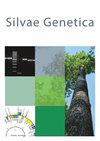3个间距短轮作林下小木香无性系生物量生产及特性研究
IF 1
4区 农林科学
Q3 FORESTRY
引用次数: 7
摘要
摘要利用短轮作树种在热带地区建立能源作物的初步尝试是以利用无性系生产木材为前提的。因此,本研究旨在研究短轮作作物中2个小木耳无性系在3个间距(1.0 × 1.0 m、0.75 × 0.75 m和1.0 × 0.5 m)内的生长方面(存活率、直径和树高)、叶构(叶面积指数[LAI]、分枝和分枝的数量和角度)、生物量产量以及24月龄时的生物量流量。直径从6个月时的3.00 cm增加到24个月时的8.0 cm,总高度从6个月时的2.00 m增加到24个月时的10.00 m。无性系成活率在20% ~ 60%之间,叶面积指数、枝角和枝状分枝随年龄增长而增加。12个月后,无性系之间的差异出现。无性系间的生物量产量相似,从6个月时的6吨/公顷到24个月时的67吨/公顷,无性系2的生物量流量大于无性系1。根据生物量生产结果及直径和高度的发育情况,建议克隆1的间距为1.0 × 1.0 m,克隆2的间距为0.75 × 0.75 m和1.0 × 0.5 m。本文章由计算机程序翻译,如有差异,请以英文原文为准。
Biomass production and characteristics of short rotation plantations of clones of Gmelina arborea in three spacings
Abstract The first attempts to establish energy crops in the tropical region using short rotation species are premised on the utilization of clones for wood production. Therefore, the present study is aimed at examining the growth aspects (survival, diameter and tree height), leaf architecture (leaf area index [LAI], number and angle of the branches and sylleptic branches), biomass production, as well as biomass flow at the age of 24 months of two clones of Gmelina arborea in short rotation crops within three spacings (1.0x1.0 m, 0.75x0.75 m and 1.0x0.5 m). The results showed an increment with age, as the diameter increased from 3.00 cm at six months to 8.0 cm at 24 months, whereas the total height increased from 2.00 m at six months to 10.00 m at 24 months. Clone survival varied from 20 to 60 %, whereas the LAI, branch angle and sylleptic branches increased with age. The differences between clones appeared after 12 months. Biomass production was similar between clones, from 6 ton/ha at six months to 67 ton/ha at 24 months, with clone 2 showing greater biomass flow than clone 1. On the basis of biomass production results and the development of diameter as well as height, clone 1 is recommended for spacing 1.0x1.0 m and clone 2 for spacings 0.75x0.75 m and 1.0x0.5 m.
求助全文
通过发布文献求助,成功后即可免费获取论文全文。
去求助
来源期刊

Silvae Genetica
农林科学-林学
CiteScore
2.20
自引率
10.00%
发文量
10
审稿时长
3 months
期刊介绍:
Silvae Genetica is an international peer reviewed journal with more than 65 year tradition and experience in all fields of theoretical and applied Forest Genetics and Tree breeding. It continues "Zeitschrift für Forstgenetik und Forstpflanzenzüchtung" (Journal of Forest Genetics and Forest Tree Breeding) founded by W. LANGNER in 1951.
 求助内容:
求助内容: 应助结果提醒方式:
应助结果提醒方式:


